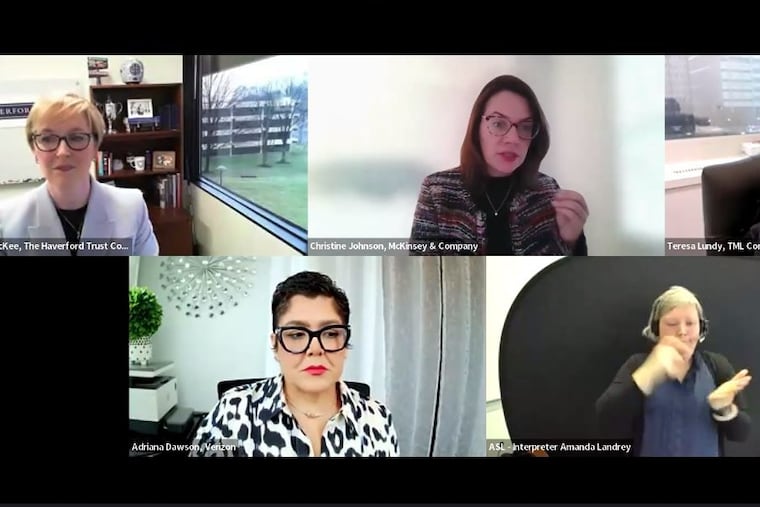Workplaces that encourage ‘being your whole self’ could help close gender gaps, female business leaders say
Burnout and microaggressions are contributing to the departure of potential female leaders from companies, local business leaders said.

Women are gaining ground in the C-suite, but progress in lower ranks of management is stalling.
That finding by consulting firm McKinsey & Co., in its latest Women in the Workplace survey report, was the root of a discussion held Thursday by the Chamber of Commerce for Greater Philadelphia. Business leaders who are women explained some of the typical workplace policies and norms that have created gender inequity, and how they can be changed.
“There’s not enough progress at the middle,” said Christine Johnson, a partner at McKinsey. “Directors and below are actually leaving the workforce at the highest rates we’ve seen.”
Johnson said promotions to middle manager for first-level manager roles are “extremely low” among women, and even lower for women of color. McKinsey has called this the “broken rung” on their career ladders.
So what’s the cause? It’s not a lack of ambition, Johnson said, citing data from the survey.
“One of the greatest threats to women in the workplace is burnout,” Johnson said, “and women who experience microaggressions are much more likely to simply leave the workplace and suffer from burnout.”
What do microaggressions look like?
McKinsey’s survey found that microaggressions — incidents of indirect, subtle, or unintentional discrimination — are more commonly noted by women working in-person with colleagues vs. remote workers, communications professional Teresa Lundy noted, and many companies have been increasing expectations of in-person work in the past year.
Adriana Dawson, a director of community engagement at Verizon, said even “well intentioned” comments can be harmful.
“They feel as though they are complimenting me when they tell me how well spoken I am because it’s surprising to them that I don’t have an accent,” Dawson, who identifies as Latina, said. “It’s rooted and based on this perception that folks might have about how people like me should speak.”
Another example, she said, is the expectation that professionals should dress in muted or neutral colors. Dawson said she prefers to wear red lipstick, animal prints, and occasionally some hoop earrings to work.
“I am going to show up my whole self [and that] may make others feel uncomfortable because they’re not used to that,” Dawson said. “I just had to learn that’s their problem, not mine.”
The panelists noted an area of progress in that regard, with the passage of the CROWN Act in nearly two dozen states. These laws prohibit discrimination based on hair texture or style.
Family leave for men can help women advance
Johnson, whose consulting clients are in the chemicals and energy industries, said one of the most encouraging changes she’s seen in recent years is not just for women. It’s the expansion of parental leave to include “secondary parents,” who are often men.
Women often return from parental leave feeling like they’re months behind their colleagues and unable to catch up, Johnson explained. They may view having children as a choice that keeps them from advancing their career.
At companies that encourage all parents to take leave after welcoming a child, Johnson said, “it’s not just mothers that have to bear the burden of the career choice.”
Hybrid work and flexibility
The challenges of balancing childcare duties with work extends beyond parental leave, Dawson noted. “We recognize that childcare is a workforce development issue and a lot of women bear the brunt,” she said.
Dawson suggested that companies should provide childcare subsidies, schedule flexibility, or other support so parents are able to continue working. She mentioned that oftentimes it doesn’t make sense financially to continue working a rigid or demanding work schedule because of the care costs required.
Having adequate pumping space available to lactating parents also removes a barrier to staying in the workforce, she said.
At the Haverford Trust Co., flexible hours and hybrid work arrangements are part of planning career paths and retaining workers, said chief marketing officer Veronica McKee. The company has seen 95% employee retention over the last decade, she said, and its employees are about 50% women throughout all levels of the company.
“We’ve kept a permanent hybrid working condition as a result of the productivity that we saw,” McKee said. “We feel like it’s working for our employees.”
Frequent mental-health checks and breaks
Like expanded parental leave and hybrid work, the business leaders said burnout prevention benefits everyone and can help with retaining women.
For McKee, of Haverford Trust, that sometimes means “making sure we measure our time off in hours, not in days.” Especially during the early days of COVID-19 lockdowns, she explained, people were working long hours and canceling vacation time to save it for later.
“We encouraged people and reminded them to take two hours off, go for a long walk, do whatever it is to be recharged [and] reduce the stress,” McKee said. That practice has continued even with the return of some in-person work, she added.
The leaders also emphasized the importance of checking in regularly on team members’ mental state. Dawson suggested doing so for three to five minutes at the start of any meeting, asking attendees about their energy levels.
Johnson said she recently experienced that kind of interaction when a male colleague checked in before starting work on a project. She happened to be late to the meeting, coming in with other stresses on her mind.
“And he actually wasn’t feeling that well. So he didn’t put it all on me,” Johnson said. “Stop apologizing for being your whole self and start realizing that can be your superpower.”
“It’s a feeling of belonging,” Dawson added. “We’re being seen.”